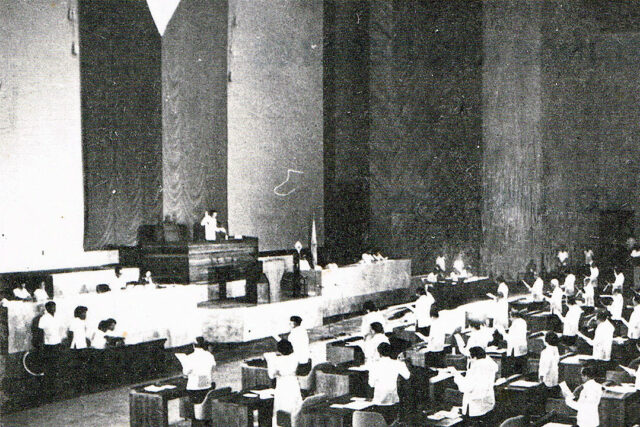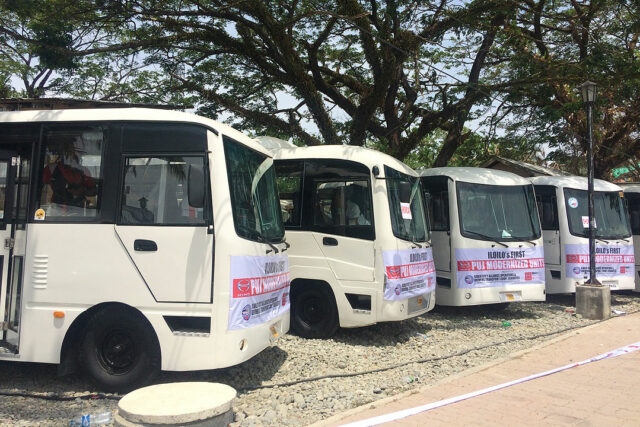THE DEPARTMENT of Foreign Affairs (DFA) should broker updated security deals with more security allies to defend the Philippines from China’s aggression in the South China Sea, a senator said on Monday.
“We have to exhaust all possible ways to defend the Philippines from China’s shameless actions,” Senator Ana Theresia N. Hontiveros-Baraquel said in a statement.
“A security agreement can serve as a defensive framework that would provide for joint patrols and training of our troops so we are prepared to work as part of a team should tensions escalate,” she added.
Ms. Hontiveros said the Philippines should not only depend on its Mutual Defense Treaty with the United States when dealing with Chinese aggression in South China Sea.
The Philippines and US earlier discussed a plan to hold joint coast guard patrols in the South China Sea.
The Philippines has also given the US access to more military bases under their Enhanced Defense Cooperation Agreement.
“The Philippines continues to protest China’s persistent and illegal presence in Philippine waters, including those near Ayungin Shoal,” Philippine Foreign Affairs spokesperson Ma. Teresita C. Daza told reporters via WhatsApp, reacting to the senator’s statement.
She said the Philippines has filed 77 protests against Chinese violations under President Ferdinand R. Marcos, 10 of which were filed this year.
This month, the Philippines filed a diplomatic protest against China as it accused its coast guard of endangering the crew of a Philippine resupply ship by pointing a military-grade laser at it on Feb. 6.
Beijing has said its coast guard had used a handheld laser to provide signal directions and ensure navigational safety.
China has rejected a 2016 United Nations-backed tribunal’s ruling that voided its claim to more than 80% of the South China Sea based on a 1940s map.
The Hague-based Permanent Court of Arbitration upheld Philippine rights to its exclusive economic zone within the waterway.
Foreign Affairs Secretary Enrique A. Manalo earlier urged the United Nations to ensure that its convention on the law of the sea is upheld by China and other neighboring states.
The UN should hold more discussions on the South China Sea to create awareness, he told a security conference in Munich, Germany this month.
“Besides creating awareness, we in the Philippines also have to lead in taking tangible steps that can urgently help our citizens who are directly affected by China’s aggression,” Ms. Hontiveros said.
Security analysts earlier said tensions between the US and China could worsen in the Indo-Pacific region this year as Washington holds its biggest joint military drills with the Philippines since 2015.
The two superpowers are expected to use their economic and cultural platforms to gain influence in the region, which has been beset by the South China Sea dispute and tensions between China and self-ruled Taiwan, they said.
Mr. Marcos visited New York last year for the United Nations General Assembly, where he called for a rule-based order in the South China Sea, which is being claimed by China almost in its entirety.
On the sidelines of the United Nations event, Mr. Marcos met with US President Joseph R. Biden.
THREE-WAY PACT
Last month, the Philippine leader met with his Chinese counterpart in Beijing, with Xi Jinping promising to find a solution to avoid tensions at sea. The two leaders signed bilateral deals covering agriculture, energy, maritime security and tourism.
Despite the Philippine-China talks, conflicts have persisted.
Aside from boosting ties with the US, Mr. Marcos has also expressed interest in a three-way defense pact with the US and Japan, which are seen as major obstacles to China’s global ambitions.
The Philippines and Australia plan to hold joint patrols in the South China Sea, Australian Deputy Prime Minister and Defense chief Richard Marles told a news briefing in Manila with Philippine Defense Secretary Carlito G. Galvez, Jr. last week.
“We did talk today about the possibility of exploring joint patrols and we will continue that work and we hope that comes to fruition soon,” he said.
“As countries which are committed to the global rules-based order, it is natural that we should think about ways in which we can cooperate in this respect,” he added.
In November, Mr. Marcos and Australian Prime Minister Anthony Albanese committed to elevate the two countries’ relationship to a strategic partnership.
Mr. Galvez told the briefing counter-terrorism and maritime security remain the “core pillars” of Philippine-Australia defense relations. He said they agreed to continue working together to maintain a “free, open and secure” Indo-Pacific Region.
The United States, a major security ally of both the Philippines and Australia, has continued to challenge China’s influence in the region.
Mr. Galvez said both the Philippines and Australia recognize the importance of collaboration between like-minded security partners to ensure nations “could freely exercise their sovereign rights” in the region while “pursuing stability and prosperity.”
He said the Philippine Navy and Air Force would boost cooperation with their Australian counterparts.
The Philippines and Australia are set to establish a regular defense ministerial meeting. Mr. Galvez said he would meet with Mr. Marles in Australia to explore joint patrols and training between their armed forces.
Mr. Marles said later this year, the two countries would sign a strategic partnership deal “which comes on top of the first meeting” between Mr. Marcos and Mr. Albanese last year.
He said Australia would boost its Indo-Pacific endeavor with more naval components, with the Philippines being a central component of it. — John Victor D. Ordoñez



![[PESO PHOTO]20180207_175609](https://www.bworldonline.com/wp-content/uploads/2021/12/PESO-PHOTO20180207_175609-640x360.jpg)









